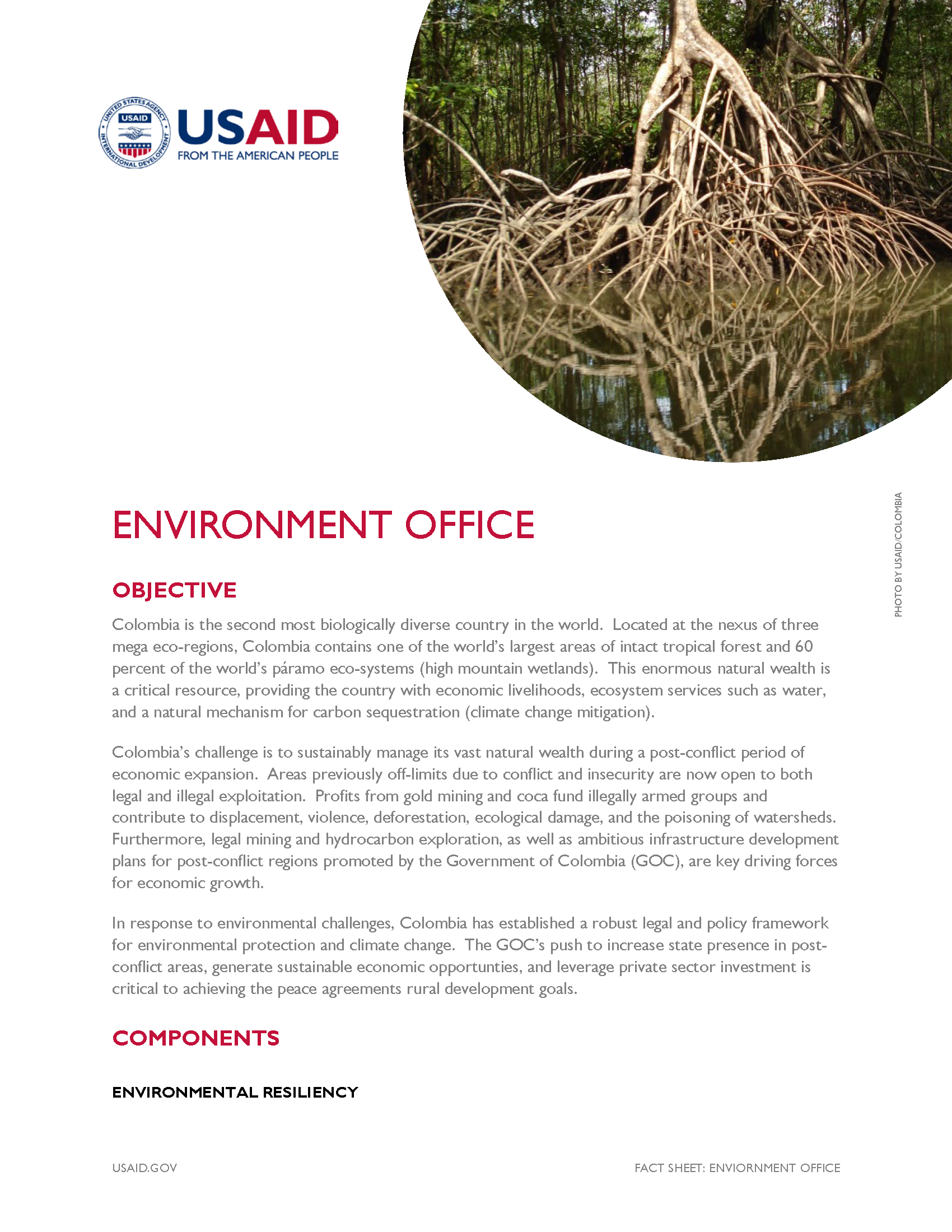Environment Office Fact Sheet ![]() (pdf - 376k)
(pdf - 376k)
OBJECTIVE
Colombia is the second most biologically diverse country in the world. Located at the nexus of three mega eco-regions, Colombia contains one of the world’s largest areas of intact tropical forest and 60 percent of the world’s páramo eco-systems (high mountain wetlands). This enormous natural wealth is a critical resource, providing the country with economic livelihoods, ecosystem services such as water, and a natural mechanism for carbon sequestration (climate change mitigation).
Colombia’s challenge is to sustainably manage its vast natural wealth during a post-conflict period of economic expansion. Areas previously off-limits due to conflict and insecurity are now open to both legal and illegal exploitation. Profits from gold mining and coca fund illegally armed groups and contribute to displacement, violence, deforestation, ecological damage, and the poisoning of watersheds. Furthermore, legal mining and hydrocarbon exploration, as well as ambitious infrastructure development plans for post-conflict regions promoted by the Government of Colombia (GOC), are key driving forces for economic growth.
In response to environmental challenges, Colombia has established a robust legal and policy framework for environmental protection and climate change. The GOC’s push to increase state presence in post-conflict areas, generate sustainable economic opportunities, and leverage private sector investment is critical to achieving the peace agreements rural development goals.
COMPONENTS
Environment Resiliency
USAID supports environmental resiliency by: 1) strengthening the GOC’s capacity to monitor emissions of greenhouse gases; 2) supporting the GOC in implementing practices to reduce emissions caused by deforestation and degradation of forest resources; 3) strengthening the capacity of the GOC and ethnic groups to link conservation efforts to market-based financing; 4) implementing clean energy projects and fostering private sector investment in energy-efficient technologies; 5) assisting GOC efforts to implement their National Low Carbon Development Strategy; and 6) developing sustainable forest management practices.
USAID assists Colombia to increase resilience to environmental changes and climate variability (changing rainfall and drought patterns) by supporting national monitoring networks, providing tools for adaptive planning, and working on adaptation strategies at the national and local levels. This also includes support to improve forecasting and early warning systems and increasing ecosystem, community and institutional resilience.
Biodiversity Conservation
USAID biodiversity activities seek to: 1) provide tools to improve decision making and implementation capacity by the regional governments, environmental authorities, and local communities to protect biodiversity and natural resources in under-protected, threatened ecosystems; 2) promote sustainable productive and extractive practices and compensation schemes where deforestation and habitat loss are the result of agricultural, infrastructure, and extractive activities; 3) incentivize adequate management of protected areas, private land conservation, and the development of ecological corridors; 4) foster the participation of local stakeholders in community-based conservation; and 5) develop payment for ecosystem services as incentives for biodiversity conservation and economic development.
Artisanal and Small Scale Gold Mining
USAID aims to reduce the use of mercury through the legalization and formalization of small artisanal gold mining. Together, with the private sector and GOC, USAID’s work helps to recover areas degraded by mining and convert them into commercial forestry plantations.
RESULTS
- Conserved 1,000,000 hectares of natural forest, delivering economic benefits to 19,000 people.
- Assisted in implementing a Tax Incentive Regulation encouraging over $620 million in clean energy investments from the private sector. Exemptions in Value Added Tax added up to $113 million since January 2013.
- Helped to approve seven sector mitigation action plans and develop 24 nationally appropriate mitigation actions.
- Installed solar and hydro installations, which electrified health and education centers in 26 communities.
- Reduced the use of mercury in gold mining practices by addressing the legalization and formalization of over 150 small-scale gold mining operations; converted more than 600 hectares of land degraded by illegal gold mining activities into commercial forestry plantations.








Comment
Make a general inquiry or suggest an improvement.